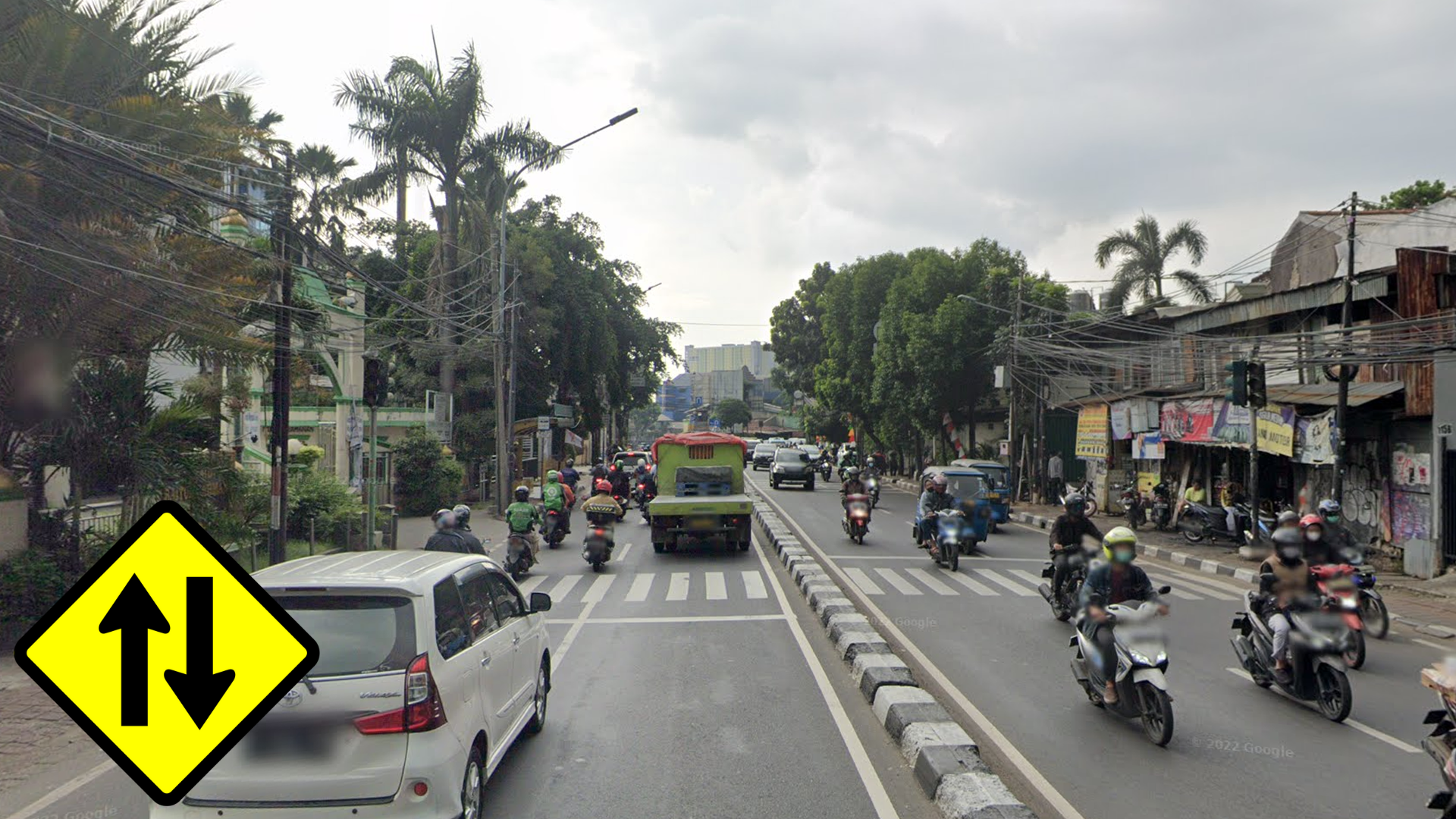
Indonesia
Indonesian licence plates are black with white letters. The letters usually appear as three white sections through the blur.
Commercial vehicles use yellow licence plates.
Plates in newer coverage can be white too.
NOTE: Malaysian licence plates are also black, but generally have two white sections.
Indonesia uses white or yellow centre lines. Outer lines will always be white. The centre lines will be solid or dashed.
In Generation 3 coverage, yellow centre lines are more rare, as Indonesia only recently started using this colour for its road lines.
NOTE: Malaysian road lines are always all white.
Poles in Indonesia are typically round and made out of either steel or concrete. Many of the steel poles are painted black, and also feature the Indonesian flag colours on them. The pole tops are usually either even or uneven, depending on the region.
You can learn more about regional poles in the region-guessing section.
Indonesia commonly uses these black-and-white square or circular bollards, as well as these yellow-and-black ones, which can also have a red reflector. Other designs can also be found.
NOTE: UK-style bollards are mostly found in Kalimantan.
Usually yellow waystones that are angled towards the road, and have a cutout close to the top are unique to Indonesia. They include shorthand for three cities or towns, with the biggest one being on the top in the cutout section.
NOTE: Waystones in the Philippines are perpendicular to the road and have the text facing away from the road.
Indonesian can look very similar to Malaysian, however Indonesian has been influenced by Dutch, and Malaysian by English. These small changes in spelling may help differentiate the two.
An example is the word television in English, which translates to ‘televisi’ in Indonesian, similar to the Dutch word ‘televisie.’ In Malaysian, it translates to ‘televisyen’, more similar to English.
You can find these rows of red and white banners all around Indonesia. Sometimes, more colourful flags can be found.
The names of 2nd level subdivisions, named ‘Kabupaten’ or ‘Kab’ for short, translating to regency, can be found all over Indonesia on various signs and billboards. Each province is split up into multiple Kabupatens, totalling to 417 which are covered by street view, and therefore applicable in Geoguessr. These are learnable with enough time and patience.
See the resources section for more information.
You can find these poles with a triangle attachment under the horizontal bar in the following regions.
NOTE: This does not apply to stacked poles.
On the Lesser Sunda Islands (“Nusas”), you can find poles with an extra support on the pole top. Sometimes, two supports can be present.
Bali features both even and uneven poles, as well as the Lesser Sunda island variants. You can also find this unique rectangle attachment on the pole tops in Bali.
Satellite dishes can help you determine whether you are north or south of the equator. For example, if the satellite dish points north, you are most likely south of it, and vice versa. The angle of the satellite dish can also tell you how far away from the equator you are. The more levelled it is, the closer you are.
The majority of rice production is concentrated in Java, but can sometimes be found in other provinces, namely South Sulawesi and South Sumatra. They can rarely be found in other provinces as well. For a full overview, see this map.
The Nusas typically look drier than other regions in Indonesia. The islands get especially dry towards the east, especially in Generation 3. Vegetation tends to look less tropical, but instead more brown with a lack of leaves. Sumba Island is also the driest of the Nusas.
NOTE: While less common, other regions such as Java can look similarly dry. Make sure to look out for other clues before guessing.
Tiled roofs are most commonly found on the island of Java, and sometimes nearby regions such as southern Sumatra, the Lesser Sunda Islands, and South Kalimantan.
NOTE: The tiles on roofs in South Kalimantan and Jambi look slightly different. The tiles are usually less rounded but flatter.
Architecture in Bali is unique because it was influenced by old Balinese culture and Hinduism. The most important thing to look for are these crown-like roof pinnacles, found everywhere in Bali. Guardian statues and slit-drum towers are common too. Andesite, a dark, volcanic rock, is a common building material in Bali. You can often see gates, walls, and other intricately carved ornaments built from this material.
Roofs with gable horns can be found most commonly in South Sulawesi, Riau and Central and South Kalimantan.
NOTE: Horned roofs are often found with Bugis roofs in South Sulawesi. Use this tip along with other clues to determine which region you are in.
A small region of South Sulawesi, around the city of Rante Pao, features these very unique houses, called Tongkonan, that have saddle-shaped roofs. The houses themselves are also elevated from the ground.
In the rare case a licence plate is unblurred, knowing regional licence plate codes can be helpful for region guessing. 1 letter codes can only be seen in Java, and are mostly found in the west. 2 letter codes can still be seen on Java, but in the east.
NOTE: The highlighted areas on the map only refer to the first letter. A detailed map of all the codes can be seen here.
You can click on the image to enlarge it.
GeoGuessr’s own official maps are not very good, for a variety of reasons. Plonk It recommends you play these maps instead:
In addition, here are some resources to help you practise Indonesia:




















































